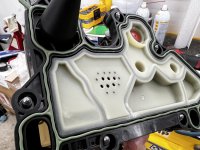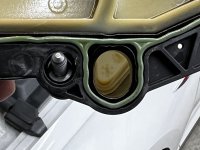DerHase
Autocross Champion
- Location
- Hampton Roads, VA
- Car(s)
- 2019 GTI Rabbit
Where can I find this data?
Loosen your oil cap at idle.
I sent my adapter to a guy in Florida who drove around with the APR CC on his GTI. At idle it pulses slightly positive pressure. We're talking 0.1-0.2psi. obviously not a "huge" amount, but there's very good reason literally zero engines are run like this from the factory.
Been a busy last ~month but will share the video when I get a chance.
There are MANY people who have reported noticeable oil leaks starting shortly after CC/plate installs.
The reason catch cans work on other platforms is they are not completely getting rid of the vacuum circuit. Our cars are kind of unique in the way the PCV is implemented.
As alluded earlier, it REALLY needs to go between the port in the cyl head and the corresponding path in the PCV valve.
All that said, my holes-drilled MK8 PCV was put on and drove the car around last night with no ill effects. Normal ~1.5inHg vacuum at idle. Pulling from the cam cover in addition to the oil port might be a way to keep oil in the bottom end.
My non modified valve does have a tiny bit of oil residue in the intake port. I have no doubt they all ingest a tiny bit of oil stock, as long as it's not enough to matter it's fine though. This is after sitting the valve on its side for 20 min while I installed the modified one. Had an oil film but no apparent accumulation on initial removal FWIW.

